
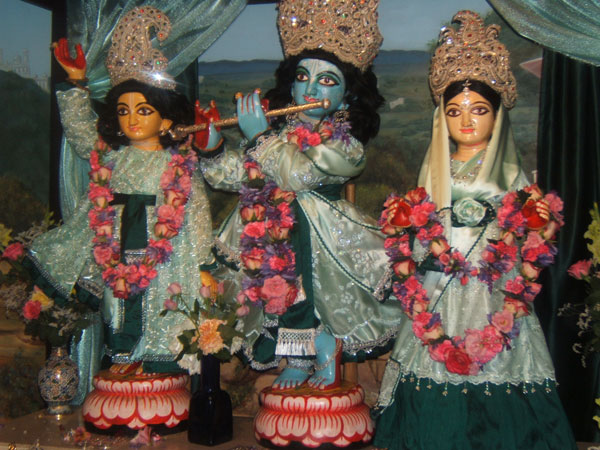
All Glories to Sri Sri Guru Gauranga Gandharvika Giridhari.
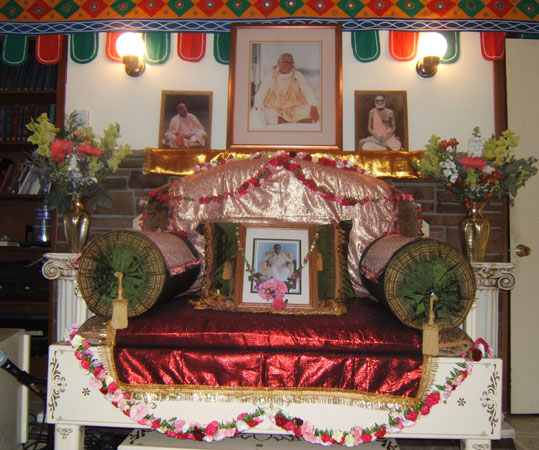
All Glories to Srila Bhakti Sundar Govinda Dev-Goswami Maharaj and our Sri Guru Parampara. How can we conceive the fortune that we have? When will we realize how fortunate we are?
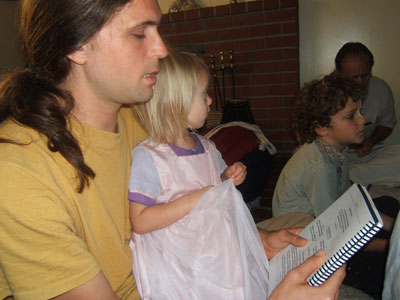
The program began with bhajans. The devotees sang several songs in honor of Sri Gandharvika.
Murali Mohan Prabhu and his daughter Anjali Devi Dasi.

Phalguni Prabhu singing along to Sri Sri Radhika Stutih.
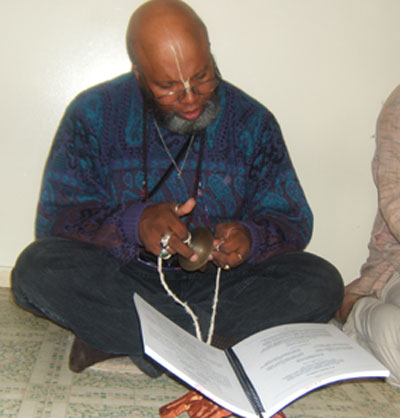
Udhavananda Prabhu playing karatals.
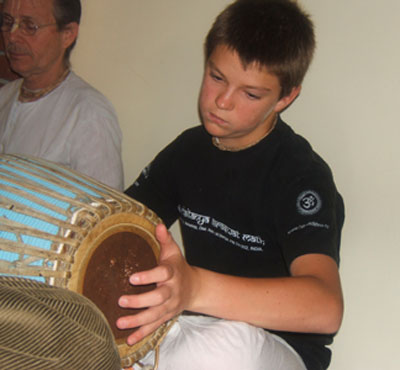
Nilamani Prabhu playing the mrdanga.
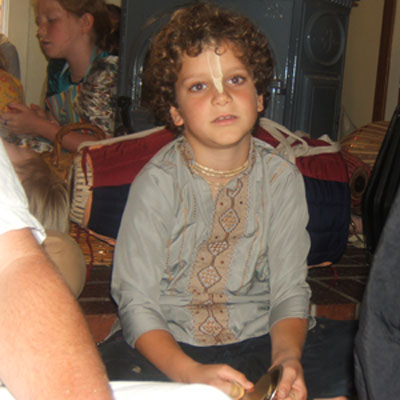
"Little Prabhu," as Gurudev calls him. Premananda Prabhu participating in the glorification of Their Lordships.
But, why do we chant bhajans? Why do we chant before the Deity? Do the karatals and the mrdanga have any particular significance?
Several devotees took the time to answer these questions.

Pusta Krishna Prabhu and his son Chaitanya Prabhu.
When asked this question, Pusta Krishna Prabhu replied:
Very simply, in Bhagavad-Gita, Krishna also takes pleasure when we glorify Him.
visanti cha ramanti cha
So when we engage in devotional service, that is pleasing to Krishna. Therefore, offering prayers, kirtan, vandanam, and hearing and glorifying the Lord are all connected with Krishna's pleasure. Everything that is pleasing to Krishna, pleasing to Gurudev, we accept.
It is not for any sentimental reason, but because this is a transcendental activity. Giving pleasure to Krishna is our eternal constitutional position of happiness.
Vaidehi Devi Dasi:
Is there any significance behind the mrdanga, and the karatals, the instruments that we use?
Pusta Krishna Prabhu:
We are to think these are transcendental instruments, that they exist
in the spiritual world. In Chaitanya Mahaprabhu's lila they are manifested
like that. Just as we have a spiritual body and we have a material body,
so there is a spiritual form of these instruments. Even if we may not
perceive them as such, they are spiritual.
Sri mrdanga is worshipable, just as the karatals and the conch-shell are worshippable because they are the parapharnalia of Krishna and Mahaprabhu. In this way, Krishna, and the whole Vrindavan, which is the environment of intimate devotion, is worshipable and non-different from Krishna.

Mathuranath Prabhu, who we had the honor to see on this auspicious day, also replied very sweetly:
Bhajan means worship. When we are chanting bhajans, that is usually a solitary performance or within a group but generally, bhajan is more of a private matter and kirtan is more congregational chanting. Bhajans are done in the mood of prayerfulness. We chant kirtan in front of the Deity and we go before the Deity to be seen by the Deity.
atah sri krishna namadi na bhaved grahyam indriyaih
When Srila Bhakti Siddhanta Saraswati Thakur established the Bag Bazaar Deities in Kolkata in the 1930's, someone said: "Oh look Maharaj! The deities are so beautiful." Srila Saraswati Thakur then said: "No, we have come here to be seen by the Deity."
Krishna is not approachable by our senses. We offer kirtan for the satisfaction of the Lord, and seeing us perform that kirtan, and by hearing us perform that kirtan, our devotional life is improved. The same with bhajan. We perform bhajan and kirtan under the guidance of a superior Vaisnava, Guru.
When we sing those songs that are composed by the great Vaisnavas, like by Srila Bhaktivinod Thakur for instance, those songs are imbued with the consciousness and the mood of dedication of the author. By chanting them in the mood of service, on the order of our Guru and the higher Vaisnavas, our spiritual life is improved. We are trying to do all of these things in a mood of service and that is basically the bottom line.
Vaidehi Devi Dasi:
Is there any significance in the instruments that we use?
Mathuranath Prabhu:
Well, karatal means keeping time. They are
meant for keeping the rhythm. The mrdanga was adopted in the time of Mahaprabhu
for the public sankirtan. So, they are traditional instruments coming
from the time of Mahaprabhu which He liked, and He is the Supreme Lord.
This is why we use them.
Vaidehi Devi Dasi:
In addition to this, can you tell us something about the significance of Radhastami?
Mathuranath Prabhu:
For us, the significance of Radhastami is the worship of Guru. This verse,
from Srila Bhakti Siddhanta Saraswati Thakur, is engraved in marble on
the front of our Math in Nabadwip:
matala harijana kirttana-range
pujala ragapatha gaurava bhange
This verse talks about that higher plane of service. We want to concentrate
here on the service of Guru and Vaisnava. By doing that, that's a tangible
way to connect with Radharani. We wouldn't dream of going directly to
Vrindavan, but like Srila Vrindavan Das Thakur said: "In the direction
that Srimati Radharani appeared, I bow my head to that." That is
as close as I need to get.
So for us, who are undeveloped in our devotional life, we want to worship
that higher plane from a distance and not try to drag it down to our own
mundane experience. We want to keep it reverentially far off above our
head and focus on the practical service of Gurudev which is relevant to
us. Another consideration of that is, this verse about Mahaprabhu that
says:
yatha yatha gaura-padaravinde
vindeta bhaktim krta-punya-rasih
tatha tathot sarpati hrdy akasmad
radha-padambhoja-sudhambhu-rasih
By giving all of our attention to Guru, Vaisnava, and to Mahaprabhu's mood, then automatically the sentiments of divine love will well up within our hearts by the grace of Guru and Vaisnava. We don't need to artificially culture those things, but from a distance, respectfully we do our service here, now, as Gurudev is giving us. In this way we will be safely making tangible progress in Radha-dasyam. Guru is the representative of Radha. Her Hladini-sakti, pleasure potency, is manifested in this world as Guru. That is how we make our connection with Krishna. It's always about Guru and Vaisnava.

Ratikantha Prabhu tells us a little more about why we chant:
Chanting is very significant because in this day and age, the yajna, or sacrifice, is chanting the Holy Name of Krishna. In the sastra it is recommended that in Kali-yuga we chant the Mahamantra:
Hare Krishna Hare Krishna
Krishna Krishna Hare Hare
Hare Rama Hare Rama
Rama Rama Hare Hare
It actually purifies the living entity so that we can become pure and self-realized. But actually, chanting the Holy Name is the first order that has been given to us by the spiritual master. When we receive divine initiation, Harinama initiation, we're asked to chant sixteen rounds a day of the Mahamantra. So this Mahamantra is very important and there are two ways we can chant the Mahamantra. One way is japa, chanting to yourself either loudly or so that it's barely audible, and another way is to chant in a congregational mood.
Chanting in a congregational mood is pretty effective because not only is the chanter and the listener getting purification, but all living entities are also getting purified. This is the process recommended by Lord Chaitanya. Performing sankirtan is the only way to achieve perfection in this day and age of Kali-yuga.
So, actually, the Nama, the Name, and Krishna Himself are non-different. When we are chanting the Holy Name it's like associating with the Lord.